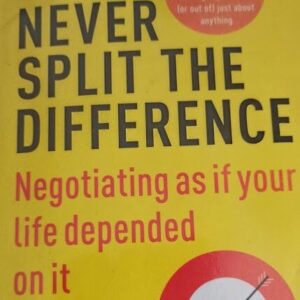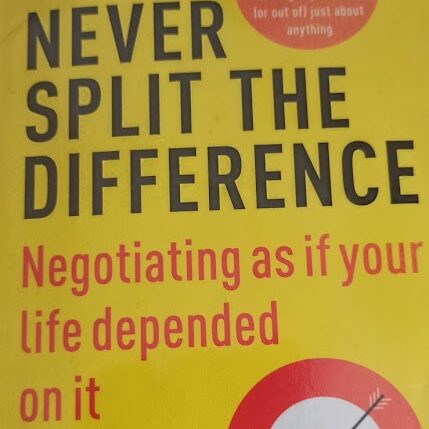Negotiation Keywords

Borrowed the book “Never Split The Difference” from the local library. A well written book from a negotiation expert where he details the key elements for a successful negotiation. I find the book an easy read and finished it off pretty fast. Gained a few timely insights from the book, at the time when I was dealing with tough situation in the project. I also reflected back on some of the key events where I had to apply some of the negotiation techniques in the book.
If you don’t want to read the book, there is a review from this blog. I would recommend that you read the book as there are stories that would set the context in each negotiation techniques.

The book shares many successful negotiation techniques. I used the methods below most often after reading the book. Upon reflecting back on my recent career challenges, I used some of the methods below unconsciously.
Mirror
I was taught mirroring conversation points from the other party early in my management career. This is where I repeat the points from the other party in the start of my negotiation response. Mirroring is supposed to show that I am paying attention and also to check for understanding of the point. Indirectly, mirroring the point also helps to ease the other party and start with an agreement.
I am more familiar with the mirroring technique when it is taught as part of “active listening” classes. I use this technique a lot when having difficult performance conversation with my team. As I set the goals for the team member in a 1-1 setting, some will push back on the goals that they have to meet. This is where negotiation comes in, first mirroring their concerns (such as “there is too much work for the short duration to meet to goal”) and slowly breaking down the possibility of the goal.
The How
Very early in the book, the author provided negotiation tips on how to turn the tough question back to the other party.
When asked for an impossible demand, ask “How can I do that?”.
I felt this was too good to be true and I have to try it for myself.
In the current program, there are a few aggressive milestone criteria for the team to meet. I had to negotiate with the higher program management team on the reality, where the team is not able to meet these goals. There was a situation where our resource was cut in half due to geo-politics of 2022 (Russian invasion of Ukraine). We definitely could not meet the software feature completion as requested. When pushed by the higher program manager on the topic, I used the “how” conversation.
I realised that the program manager was now helping me to craft the solution, throwing some ideas that I can bring back to the team. She also later helped to craft our impact positively to higher management, to a point we are getting sympathy and understanding in a difficult conversation. With other relationship building techniques, I feel that the tough program manager has started to build trust with me and the team. I can feel less push back from her when we are negotiation difficult issues.
The What
I tend to ask “Can you please fix this issue?” when giving direction to the team member. Theoretically the response should be a yes or a not, but everyone knows this is a ask to do the work. After reading the book, I have started to use “what” to replace “can you” questions.
To start the negotiation, I would ask “what can be done to fix the issue?”.
I have mindfully rephrased questions to start with “what” and it is giving interesting results.
Firstly, tough problems are starting to be a conversation instead of the other person being defensive. I am asking an open ended question, the answer can sometimes be creative. There are cases where I am asked to bring in an expert to have a look. Then there’s times where the person took up the challenge to find the answer to fix the issue instead of being asked to do it.
While “what” works most of the time, there are occasions where I have to set the context and constrains. “What” opens up a pandora’s box of creative answers, it sometimes takes a long way to get to the answer. It is not always the right tool to use if you have a clear direction to the solution and is in a crunch.
Use the tone, control the environment
The author was using the analogy of using “late night DJ” voice in a heated negotiation. I call this matching or mismatching the energy in the negotiation. This is where you can bring a situation to be hyped up or mellow down from the tone of my voice.
When I first took up the engineering leadership position, we had a change in organisation. The new director had a online meeting with me to discuss structing my team. He is a very fast paced, excited and aggressive person. It shows in the tone and speed of his speech, to a point it feels intimidating and overbearing. To bring down the excitement level, I spoke calmly and in a very low town. I can feel his pace was also slowing down and we are able to have meaningful back and forth conversation.
Towards the end of the discussion he did ask whether I am excited as he is since I sound tired. That was when I realised there is a fine line between sounding mellow and disinterested.
Conversely, I have used my excited tone when starting my weekly program meeting to get the energy up. Normally group meetings are held later in the evening when people’s energy is expanded. I start with a positive acknowledgement on their progress, calling out specific achievements if possible. I find people tend to be more focused with a more energetic meeting, especially with a group of people.
Label
I was taught labelling in leadership trainings although we do not call it that. The book explains labelling as a term we throw at the other party to explain what we think they are feeling. I use this method sparingly when talking to team members when I was a people manager. I use labeling to break up a long rant or complain, telling them “I can hear that you feel disappointed?”. This will normally trigger further conversation on what the are really feeling or thinking, which drives more discussion on the real problem. This is when we can find the rootcause before going for the fix.
I have not been very successful in getting positive negotiation results through labelling. I think this is because I am not prepared with the follow up conversation once I get the response from the other party. An example, I had tried to label a negative emption during a performance feedback. We acknowledge the feeling and that was the end of the conversation. I feel there should be more that I can do to push for results after labelling.
To Close
The book is worth the read. Author claims we negotiate all the time, even with our kids. There are a lot more techniques in the book that is worth reading through. I believe the techniques need to be used based on the situation. It is not a one size fits all, so there’s still a lot for me to learn from the book. Learning and reading is the start, putting the knowledge into practice takes a lot of mindfullness, for example using “what” to replace “can you”.